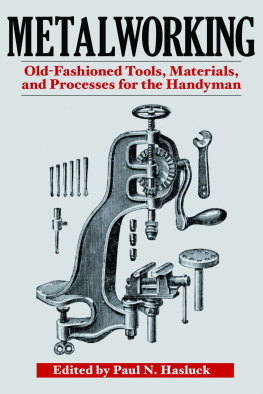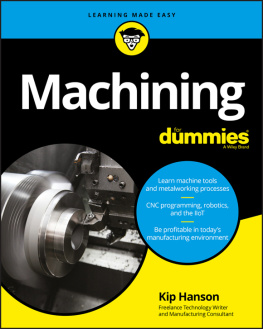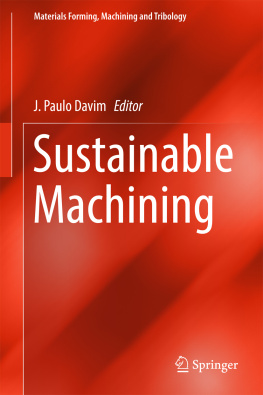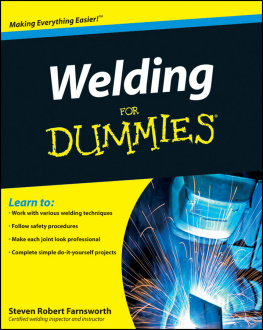

Machining
Welding
Fabricating
Tom Lipton
INDUSTRIAL PRESS INC.

Machining
Welding
Fabricating
A full catalog record for this book is available from the Library of Congress.
ISBN 978-0-8311-9092-7
Lipton, Tom.
Metalworking doing it better: machining, welding, and fabricating/Tom Lipton.
ISBN 978-0-8311-3476-1 (softcover)
Industrial Press, Inc.
32 Haviland Street, Unit 2C
South Norwalk, CT 06854
Sponsoring Editor: John Carleo
Developmental Editor: Robert Weinstein
Interior Text and Cover Design: Janet Romano
Composition: Thomson Digital
Copyright 2014
by Industrial Press Inc. All rights reserved.
This book, or any parts thereof, may not be reproduced, stored in a retrieval system, or transmitted in any form without the permission of the publisher.
10 9 8 7 6 5 4 3 2 1

W hen I completed work on my first book, Metalworking: Sink or Swim , I included the following acknowledgments, which still hold true today.
This book might never have existed had it not been for a few important people. I would like to take a moment here to thank them properly.
Without my wife Sargamo, I dont think this book would have ever been finished. She was able to cheer me on at key points and breathe some life back into me. As a fellow metalworker, she can read this material and understand it fully. We met in a welding shop 2 5 y ears ago and, for some unknown reason, she has not cut me loose yet. We have the dubious and unique honor of having the worst fight of our marriage over a pair of really nice C-clamps at the flea market. She can bring home the bacon as well as weld me under the table with one hand tied behind her back. In addition to her metalworking skills, she doggedly tried to improve my grammar and punctuation in micrometer-like steps.
I would like to thank all the metalworkers who have gone before me, on whose shoulders I am standing. Looking ahead to the future, I dont like what I see for the skilled trades. I am doing everything I can to make sure nothing dies that shouldnt. I have learned from so many people it would be a book of its own to thank everyone properly.
Chris Owen may not be what I would call a career metalworker, but I still owe him a little credit. He had the dubious honor of letting the book-in-progress out of the bag at WESTEC 2006 to an unexpected warm reception. By the way, Chris, you still owe me a lunch.
I believe that my parents had a strong hand in shaping my life as a metalworker from the day when I was nine in the basement learning how to weld with my dad to my mom fronting the money for my first welding machine. How could I fail with support like that?
Thanks to all!
Tom Lipton
August 2008
Now as I complete work on Metalworking: Doing It Better , I want to say thanks to a few important people who helped me with this second volume on my favorite subject, metalworking. Without support and encouragement from my publisher Industrial Press and their professional editing, this volume would be less perfect than it is now. Thank you to Robert Weinstein for doing the heavy lifting and to John Carleo for encouraging me to take on this project in the first place. Another special thanks goes out to the amazing Janet Romano for wading through a truckload of pictures of strange things and arranging them into a meaningful coherent work. I had the easy part. All I had to do is do what I love which is the metalworking part. These dedicated folks really insisted and worked hard to make sure that it would be a really good book. I hope you agree.
My wife deserves another special thanks for taking yet another bullet for the team. She still has not cut me loose she put up with me huddled behind the computer whittling away when she wanted to watch Breaking Bad or True Blood episodes. I owe her big time on this one.
Im sure there are a few more folks who I missed and who deserve some acknowledgment for the parts they played in getting this book to you; I apologize in advance because it is definitely not intentional.
Sincerely,
Tom Lipton
August 2013
I always wanted to write a book. I started more than my fair share actually, but for numerous mostly lame reasons never was able to finish any. Then a few years ago, Metalworking: Sink or Swim came together. Ive been pleased with the result and am very happy now to be moving forward with other book projects like this one. Whereas my first book was aimed primarily at machinists, welders, and fabricators who work in larger metalworking shops, this book as aimed toward small scale DIY (do it yourself) operations, including those you might find in maker shops and small business.
Career Metalworker is probably the best way to describe me. As I work on this manuscript, half a century has passed under my bridge since I was hatched and I still love metalwork. I may not have loved all the jobs I have done or all the places I have worked, but I have always loved the trade. My parents might have had a small clue I was destined for the trades after my mom gave me the serrated saw off an aluminum foil box, which I put to good use sawing up the arms of her nice dining room chairs.
Maybe a more accurate description of me would be that I love the skilled trades. I can appreciate and be humbled by the violinmaker, the plumber, and the tugboat captain. The act of building something is deeply satisfying and difficult to explain to people outside the trades. Wherever humans pick up tools and work with materials, machines, and a skilled hand, this is where I want to be.
The only caveat is that it must be done well. This appreciation for attention to detail was drummed into my head by some of the old guys, more by osmosis and boot in the rear than any direct action on my part. I always felt that I let them down if I did a bad job or something didnt quite come out the way they wanted it. Most of the time, however, they didnt even have to say anything. You knew from the look on their faces or a callused hand sliding over the offending detail that you had somehow failed slightly. The answer for me was to try harder the next time and learn from the experience.
Call me strange, but I love the sight, sounds, and smells of a working shop (see ). Each has its own distinct flavor and heartbeat. The smell of hot metal and cutting oil brings certain memories out in clear relief. Almost any welder can smell a piece of paper burning halfway across the shop in the middle of cutting steel plate with a torch, sniffing the air like a bloodhound looking for the start of a fire. We can tell which shop the boss sent the grinding work out to by the smell of their cutting oil.
These shops we work in get into our blood in more ways than you know. The squeal of a tortured cutting tool, the clank of a pair of vise-grips opening, or the sound of a tack weld breaking is as recognizable as your own name called by your mother in a noisy room.
My first experiences in metal working started with welding. My father taught me how to stick weld when I was nine years old in the dark basement of our house in Berkeley. Like the sailors who get the open ocean into their blood, I can say this is the moment I was infected by a fascination with metalworking or, at least at that point, welding.
Next page










